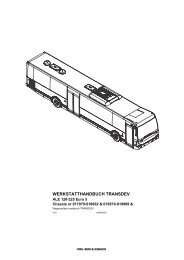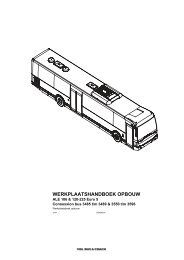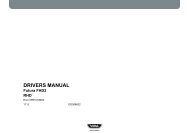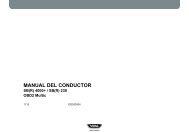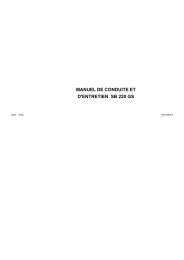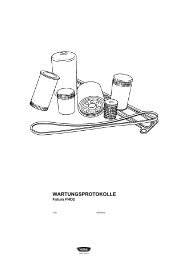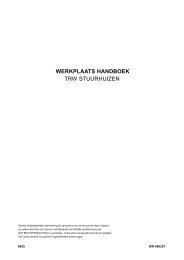DRIVER'S MANUAL SB220GS - Training Registration System
DRIVER'S MANUAL SB220GS - Training Registration System
DRIVER'S MANUAL SB220GS - Training Registration System
Create successful ePaper yourself
Turn your PDF publications into a flip-book with our unique Google optimized e-Paper software.
IMPORTANT INSTRUCTIONS<br />
In order to avoid damage to the vehicle,<br />
follow the instructions mentioned<br />
beneath.<br />
RUNNING IN<br />
During running in, do not overload the new<br />
vehicle.<br />
This also applies if a reconditioned motor,<br />
gearbox or differential have been installed.<br />
The following applies to the first 3000 km:<br />
- Do not drive with full load<br />
At cold start use a low gear and moderate<br />
rotational speed until the coolant has<br />
reached about 50°C.<br />
While driving, check the instrument panel<br />
regularly and act upon possible irregularities.<br />
Do not let the engine idle unnecessarily.<br />
This is harmful to the engine and also<br />
causes unnecessary pollution of the environment.<br />
Keep in mind that engine stalling while<br />
driving influences servo steering. Steering<br />
will require more strength.<br />
Let the engine idle for a while before turning<br />
if off after a long trip or high performance.<br />
The engine cooling system is thermostatically<br />
controlled. Therefore, never use a<br />
muff on the radiator in cold weather.<br />
When the coolant temperature is (too) high,<br />
removing the thermostat will only cause<br />
the engine temperature to rise to an even<br />
higher level.<br />
The turbocharger is a precision instrument.<br />
Therefore, all abnormal noise that seems<br />
to be coming from the turbocharger should<br />
be reported immediately.<br />
AIR LEAKAGE<br />
If the pressure in the air reservoirs drops<br />
rapidly, this indicates a leak. Since this<br />
affects the safety of the brake system, the<br />
leak should be traced and repaired as<br />
quickly as possible.<br />
VOLTAGE<br />
The vehicle is equipped with a 24 Volts<br />
electrical system.<br />
When replacing or installing electric/<br />
electronic components, check if these are<br />
suited for this voltage.<br />
BATTERIES<br />
Never disconnect the battery<br />
pole clamps while the engine<br />
is running.<br />
When charging the batteries, make sure you<br />
are in a well-ventilated area and avoid<br />
sparking or open fire. Do not use a battery<br />
quick-charger unless absolutely necessary;<br />
for this involves disconnection of the battery<br />
cables.<br />
8<br />
IMPORTANT INSTRUCTIONS



